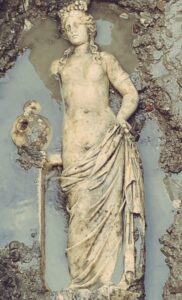
The statue is life-sized at 1.53 meters (five feet) high and depicts a nude female figure resting on an urn perched atop a pilaster. Her right hand clutches the robe draped loosely over her hips. Her hair is tied in a Herakles knot (aka an Aphrodite knot), a hairstyle that originated in Early Classical (5th century B.C.) depictions of Apollo and then became popular in statues of Aphrodite and other deities throughout the Classical, Hellenistic and Roman eras. It looks to me from the picture that there might even be remnants of blue polychrome on the draped robe, although that could just as well be some sort of stain.

Pliny the Younger, nephew and heir of the famed author of Natural History who died trying to save his friends from the eruption of Vesuvius in 79 A.D., was appointed imperial governor of Bithynia-Pontus by the Emperor Trajan in 100 A.D. Many of his letters have survived, including his letter to the historian Tacitus describing the eruption that took his uncle’s life, and his correspondence with Trajan. Around 112 A.D., he wrote to Trajan about Amastris in particular.
The elegant and beautiful city of Amastris, Sir, has, among other principal constructions, a very fine street and of considerable length, on one entire side of which runs what is called indeed a river, but in fact is no other than a vile common sewer, extremely offensive to the eye, and at the same time very pestilential on account of its noxious smell. It will be advantageous, therefore, in point of health, as well as decency, to have it covered; which shall be done with your permission: as I will take care, on my part, that money be not wanting for executing so noble and necessary a work.
Trajan’s reply:
It is highly reasonable, my dearest Pliny, if the water which runs through the city of Amastris is prejudicial, while uncovered, to the health of the inhabitants, that it should be covered up. I am well assured you will, with your usual application, take care that the money necessary for this work shall not be wanting.

* This article was originally published here






No comments:
Post a Comment